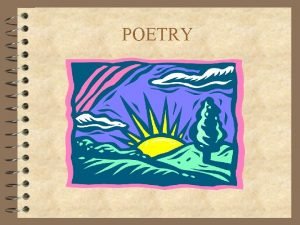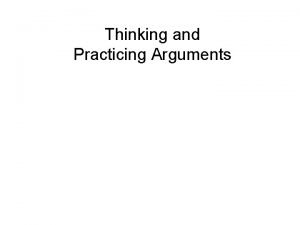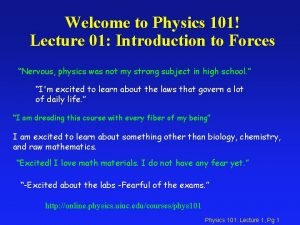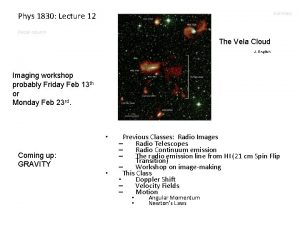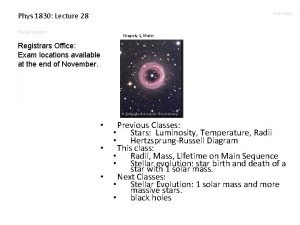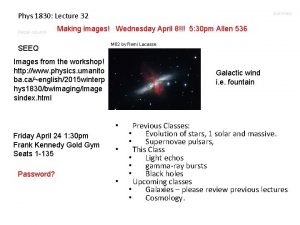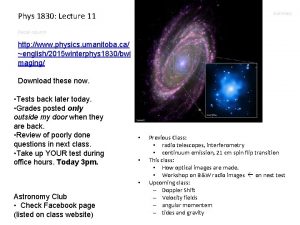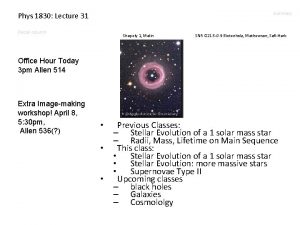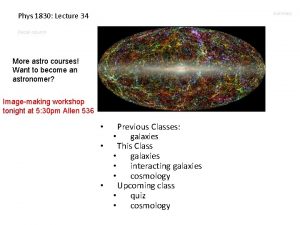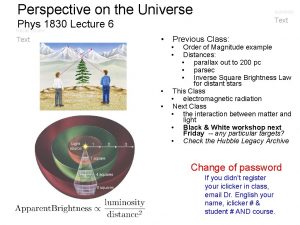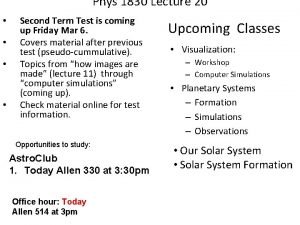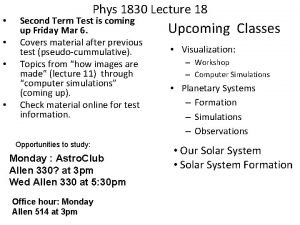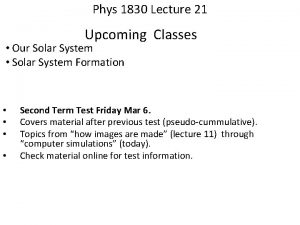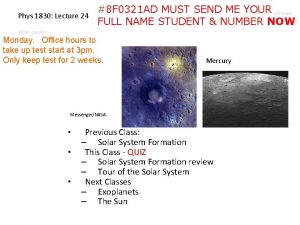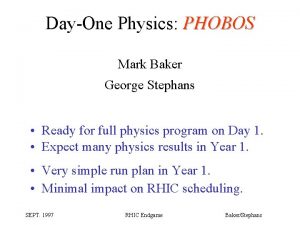Stephans Quintet Phys 1830 Lecture 14 summary Recall































- Slides: 31

Stephan’s Quintet Phys 1830: Lecture 14 • • summary Recall column Previous Classes: – Newtonian Gravity – – tides Interacting Galaxies – Interacting Galaxies continued Constant acceleration Orbits and mass J. English This Class: • • – – • Dark Matter Einstein’s Gravity Gravitational lensing. • Next Classes: • Image-making Take up tests at office hour Oct 21 or appointments at other times.

Imaging Workshop coming up next Friday summary Recall column • Bring images you stretched OR from • http: //www. physics. umanitoba. ca/~ english/2013 fallphys 1830/bwimagin g/ • I posted stretched images at website in case you didn’t stretch images. • work in teams again.

Tidal Force Examples: Groups of Galaxies summary Recall column Image credit: J. English • Galaxies residing in groups also feel tidal forces.

Tidal Force Examples: Groups of Galaxies – velocity fields summary Recall column J. English • 2 tidal arms in the upper galaxy – major merger. • One long arm to the left in the left galaxy – minor merger. • Cloud is likely to be tidal debris.

Tidal Force Examples: Clusters of Galaxies summary Recall column J. Dubinski • Groups which have hundreds to thousands of galaxies are called clusters. • Gravitas - http: //www. galaxydynamics. org/

Motion in a Gravitational Field Can we predict the velocity at which a planet orbits a star? Does a falling heavy object speed up compared to a falling light object? How do we know that there is Dark Matter?

Combining Forces of Motion and Gravity: Constant Acceleration Recall column and • Force on an object due to orbital motion is equal to the force on object due to gravity. • mass of the smaller object cancels out. summary

Combining Forces of Motion and Gravity: Constant Acceleration summary Recall column • Consider 2 objects of different mass feeling the pull of gravity from M. • mass of these objects doesn’t matter. • Start 2 objects at same distance from centre of gravity acceleration on them is constant.

What do you predict? Recall column summary • Drop a hammer and a feather at the same time. Ignoring friction, which statement would be true? a) The hammer hits the ground before the feather. b) Both hit the ground at the same time.

Combining Motion and Gravity: Constant Acceleration summary Recall column • The moon’s atmosphere is insignificant (frictionless environment). • Can see that objects of different mass feel a constant acceleration in a gravitational field. The hammer and feather land at the same time.

Motion of an Object: Gravity, Velocity and Mass Recall column summary • The relationship between acceleration and velocity for an orbit is • Also an expression for acceleration is generated by setting • Equating these 2 expressions for acceleration gives

Mass in Galaxies: summary Recall column Rearranging the equation gives: • Any time that there is an object in orbit around another object, we can determine the mass of the central object! • e. g. the moon’s orbital velocity and distance from the Earth can be used to “weigh” the Earth.

Plot Velocity Equation for planets the Solar System: Recall column summary • The sun contains 99. 85% of the mass in the solar system so we can ignore the contribution of the mass of the planets. i. e. M is constant. • Keperlian motion.

Mass in Galaxies: summary Recall column The general shape of rotation curves is a) the same as the velocity vs radius plot for the solar system. b) is flat or rising which is the same as for Keplerian motion. c) is flat or rising which is different than Keplerian motion.

Mass in Galaxies: summary Recall column Rearranging the equation gives: • In a galaxy’s rotation curve, at a large radius the velocity remains constant (the plot is flat). • If radius increases, then the mass is increasing! • This is called the “dynamical mass”. • The dynamical mass consists of all matter – stars, gas, dust, etc.

Galaxy rotation curves Mass increases out to the last measured radial point. Solid body rotation in centre but flat (i. e. constant velocity in outer regions.

Mass in Galaxies: summary NGC 3556 R. Gendler HI velocity field of NGC 3556 Recall column 1. Sum up all the luminous radiation (xray gas, optically visible stars, infrared dust, cold HI in the radio). Convert this into the mass required to produce this amount of radiation. the luminous mass. 2. Calculate the dynamical mass out to the furthest radius we can measure.

Mass in Galaxies: summary NGC 3556 R. Gendler HI velocity field of NGC 3556 Recall column Dynamical mass is much greater than the luminous mass! 90% of the mass in a galaxy is not luminous. This material is called Dark Matter. Since it extends beyond the disk, we say a galaxy has a dark matter halo. Discuss what this matter might be with your neighbours. We will talk more about this later in the term.

36. According to their rotation curves, most spiral galaxies a) rotate as a solid body only b) rotate counterclockwise c) have decreasing rotational speeds with increasing distance d) contain dark matter e) contain dark energy (Hint: Does “energy” have mass? What is dark energy? )

Example of a question which tests concepts. It is possible to ``weigh'' a planet, for example, with the following information about: a) the planet's flattened shape (oblateness) and reflectivity (albedo). b) the moon's orbital speed and its rotational speed. c) using only the distance between the planet and moon and the orbital speed of the moon. d) none of the above because there is no known way to determine the mass of planets.

Seeing Gravity: summary Recall column • These are remarkable images. • The arcs are not scratches on the film or bleeding in the CCD. • These are gravitational lenses. • Lenses are described by Einstein’s General Theory of Relativity.

General Relativity (GR): Recall column summary • Motivation: – The speed of light is measured to remain constant regardless of the speed of the observer. – Newton’s laws are inaccurate for extraordinarily concentrated masses and large accelerations. • GR is a geometrical view concept of gravitational field. • GR has 4 dimensions: 3 spatial dimensions and 1 time dimension spacetime.

General Relativity (GR): Recall column summary • Uses Einstein’s Field Equations. • Definition: The presence of mass curves spacetime and we interpret the curved motion (i. e. orbits) of particles in curved spacetime as acceleration due to a force, i. e. gravity. • In the case of small mass or small acceleration, Einstein’s Field Equations reduce to Newton’s laws of gravity and F = ma • Really is a “law” rather than a theory.

summary Recall column We got to here. Although the rest will be reviewed in the next class, please read ahead.

GR: Gravitational Lensing summary Recall column • A foreground object like a galaxy (or a cluster of galaxies) bends the fabric of spacetime. • Light must travel in spacetime so it bends around the curve. • Projecting back onto the celestial sphere we see more than one image of an unresolved background galaxy (e. g. quasar).

GR: Gravitational Lensing summary Recall column • A background galaxy will be made into arcs by the foreground lensing galaxy or cluster of galaxies. • All of the matter in the foreground galaxy (luminous and dark) bends spacetime.

Seeing Gravity: summary Recall column • The clusters are acting as lenses. • The arcs are background galaxies. • Using GR we can determine how much matter must be in the foreground cluster in order to create the arcs. • Measuring up all the luminous emission (x-ray through radio) gives the amount of mass due to processes that produce EM radiation. • The lensing mass is much greater than the luminous mass in the cluster Dark Matter! • (Changes to Newton’s Laws won’t make DM go away)

Seeing Gravity summary Recall column • A single galaxy lensing a background galaxy.

Seeing Gravity summary Recall column General Relativity is applicable to everything from the precession of the planet Mercury to your cell phone. On the shuttle (in orbit therefore accelerating) the astronauts measure time, using atomic clocks, to be moving slower than the folk in mission control spacetime! • A single galaxy lensing a background galaxy Dark Matter.

Fill in the Blank Question: Recall column summary The lensing of a distant quasar is produced by ____ of a foreground galaxy. A) all the normal matter and dark matter B) only the mass of the black hole in the centre of a galaxy C) an individual star D) a supernova’s intense magnetic field

Requirements for the Workshop on Friday summary Recall column • All materials are at http: //www. physics. umanitoba. ca/~english/2013 fallphys 1830/bwimaging/ 1. GNU Image Manipulation Package (GIMP). a) b) You can use Photo. Shop IF you are an expert and your version has “screen mode” in layers. Run GIMP to set up your preferences before you get to class. 2. Black and White image jpegs – either your own or mine. • Workshop material will be on November test. • Let me know if you need a power socket for your laptop.
 Stephans law
Stephans law Phys 241 lecture quizzes
Phys 241 lecture quizzes Quatrain couplet
Quatrain couplet The quintessential quintet
The quintessential quintet Couplet triplet quatrain quintet
Couplet triplet quatrain quintet Blank verse
Blank verse Couplet triplet quatrain quintet
Couplet triplet quatrain quintet Nmr singlet doublet triplet
Nmr singlet doublet triplet 01:640:244 lecture notes - lecture 15: plat, idah, farad
01:640:244 lecture notes - lecture 15: plat, idah, farad Liberty leading the people, 1830
Liberty leading the people, 1830 Ensayos constitucionales de chile entre 1823 y 1830
Ensayos constitucionales de chile entre 1823 y 1830 Us map 1830
Us map 1830 Two complaints of tejanos in 1830
Two complaints of tejanos in 1830 Who signed the indian removal act of 1830
Who signed the indian removal act of 1830 Outline map the indian removal act of 1830
Outline map the indian removal act of 1830 Map of america 1830
Map of america 1830 Congressional act of 1830
Congressional act of 1830 Liberty leading the people, 1830
Liberty leading the people, 1830 Constitucion de ecuador 1830
Constitucion de ecuador 1830 5 i's of romanticism
5 i's of romanticism 1830-1886
1830-1886 Moti del 30 31
Moti del 30 31 Where did revolution spread in 1830
Where did revolution spread in 1830 Terzo libro del pentateuco
Terzo libro del pentateuco I moti del 1830-31
I moti del 1830-31 Liberty leading the people 1830
Liberty leading the people 1830 Indian removal act of 1830
Indian removal act of 1830 Candy crush 1830
Candy crush 1830 Indian removal act of 1830
Indian removal act of 1830 Språkdebatten 1900
Språkdebatten 1900 Uiuc physics 102
Uiuc physics 102 Phys 101 uiuc
Phys 101 uiuc


